List of local nature reserves in Berkshire
Local nature reserves (LNRs) in England are designated by local authorities under Section 21 of the National Parks and Access to the Countryside Act 1949.[1] LNRs are sites which have a special local interest either biologically or geologically. Local authorities have a duty to care for them, and must control the sites by owning or leasing them, or by having an agreement with the owners. The local authorities can apply local byelaws to manage and protect LNRs.[2]
.jpg.webp)
As of January 2020, there are forty-one LNRs in Berkshire.[3] Five are also Sites of Special Scientific Interest, two are Special Areas of Conservation and four are managed by the Berkshire, Buckinghamshire and Oxfordshire Wildlife Trust.
Berkshire is a county in South East England.[4] It is bordered by Hampshire and Surrey to the south, Greater London to the east, Wiltshire to the west and Buckinghamshire and Oxfordshire to the north.[5] Berkshire lies in the valleys of the Thames and its tributary, the River Kennet, and in the west it is crossed by chalk hills.[6] It has a population of more than 860,000. It is no longer an administrative county following the abolition of Berkshire County Council in 1998. It is governed by six unitary authorities: Bracknell Forest, Reading, Slough, West Berkshire, Windsor and Maidenhead and Wokingham.[7]
Key
Other designations and wildlife trust management
Sites
| Site | Photograph | Area[lower-alpha 1] | Location[lower-alpha 2] | Borough | Other | Map[lower-alpha 3] and details[lower-alpha 4] | Description |
|---|---|---|---|---|---|---|---|
| Alder Moors | .jpg.webp) |
8.5 hectares (21 acres) | Woodley 51.459°N 0.886°W SU 775 739 |
Wokingham | Map and details | This ancient wood is named after the alder trees which dominate it. Other species include ash and willow. Ground flora include marsh marigolds, primroses and anemones.[8] | |
| Ali's Pond |  |
0.4 hectares (0.99 acres) | Sonning 51.470°N 0.913°W SU 756 751 |
Wokingham | Map and details | More than 40 aquatic and wetland plants and 18 species of dragonfly have been recorded at the reserve. Other fauna include great crested newts, harvest mice, stag beetles, song thrushes and pipistrelle bats.[9] | |
| Ambarrow Court | 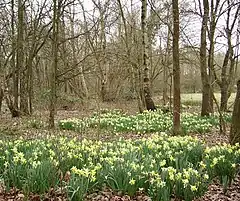 |
7.8 hectares (19 acres) | Sandhurst 51.356°N 0.817°W SU 825 625 |
Bracknell Forest | Map and details | This site, which was once part of a Victorian country estate, has ancient woodland, birch and hazel coppice, marsh, ponds and a meadow. Fauna include noctule bats, glow worms and stag beetles.[10] | |
| Arthur Jacob Nature Reserve | 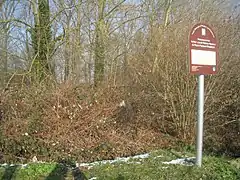 |
4.1 hectares (10 acres) | Horton 51.472°N 0.530°W TQ 022 758 |
Windsor and Maidenhead | Map and details | The reserve has four former gravel pits which have been converted from derelict land into lagoons managed for wildlife. There are several islands and the site has been planted with trees and shrubs, while some areas have been turned into wildflower meadows.[11] | |
| Bisham Woods |  |
85.7 hectares (212 acres) | Cookham 51.556°N 0.765°W SU 857 849 |
Windsor and Maidenhead | SAC,[12] SSSI[13] | Map and details | Most of this site is broad leaved woodland on well drained chalk soils, together with some areas on wet clay and others on glacial sands and gravels. It has one of the richest ground floras of any wood in the county, with dog's mercury and ivy dominant. There are also mollusc species characteristic of ancient woodland on chalky soils, such as the snails Helicigona lapicida, Pomatias elegans and Cochlodina laminata.[14] |
| Blundells Copse | _cropped.jpg.webp) |
5.6 hectares (14 acres) | Reading 51.456°N 1.033°W SU 673 734 |
Reading | Map and details | A stream runs through this area of ancient woodland. There are fauna such as bats, hedgehogs, muntjac deer, field mice and frogs, while flora include opposite leaved golden saxifrage, marsh marigold, yellow archangel and fool's-water-cress.[15] | |
| Bradnam Wood | .jpg.webp) |
12.5 hectares (31 acres) | Maidenhead 51.549°N 0.780°W SU 847 840 |
Windsor and Maidenhead | Map and details | This site has mature woodland at the northern end and more recently planted trees in the south. In the middle is a field which has chalk grassland plants and large anthills.[16] | |
| Braywick Park | .jpg.webp) |
12.7 hectares (31 acres) | Maidenhead 51.512°N 0.710°W SU 896 800 |
Windsor and Maidenhead | Map and details | This former quarry has areas of parkland together with areas managed for wildlife with grassland, woodland a pond.[17] | |
| Carpenter's Wood | .jpg.webp) |
21.4 hectares (53 acres) | Maidenhead 51.537°N 0.785°W SU 844 827 |
Windsor and Maidenhead | Map and details | The site consists of two adjacent woods, Carpenter's Wood and Dungrovehill Wood. It lost half of its mature beech trees in the storms of 1987 and the early 1990s.[18] | |
| Clayfield Copse |  |
8.7 hectares (21 acres) | Caversham 51.488°N 0.957°W SU 725 771 |
Reading | Map and details | This site has mature woodland, fields managed as recreational areas, other fields left to regenerate as woodland, a wildlflower meadow and a sculpture trail. There are also ancient ditches and boundary banks. The woodland has a wild pear and wild service tree.[19][20] | |
| Cocksherd Wood | .jpg.webp) |
4.8 hectares (12 acres) | Slough 51.536°N 0.639°W SU 945 828 |
Slough | Map and details | This ancient wood has diverse fauna and flora, including field maple, wild cherry, birch, oak, hazel, beech, honeysuckle and blackthorn.[21] There is a display of bluebells in April.[22] | |
| Edgbarrow Woods | 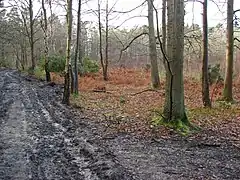 |
36.8 hectares (91 acres) | Crowthorne 51.358°N 0.805°W SU 833 628 |
Bracknell Forest | Map and details | This reserve has semi-natural woodland, wet and dry heath and acidic grassland. Fauna include noctule bats, glow-worms, silver-studded blue butterflies, and such birds such as hobbies, bullfinches and Dartford warblers.[23] | |
| Englemere Pond |  |
26.4 hectares (65 acres) | Ascot 51.408°N 0.702°W SU 904 685 |
Bracknell Forest | SSSI[24] | Map and details | This large pond is surrounded by marshland. It is dominated by common reed, and other flora include bog mosses, sundew, bog pondweed, spike-rush and St John's-wort. The swamp also provides a habitat for a variety of breeding birds, such as sedge warblers and reed bunting. There are areas of woodland a small heath.[25] |
| Farley Copse | .jpg.webp) |
33 hectares (82 acres) | Bracknell 51.419°N 0.780°W SU 849 696 |
Bracknell Forest | Map and details | This area of ancient woodland has flora such as wood anemones and dog violets. It has a pond with large red damselfies and broad-bodied chaser dragonflies.[26] | |
| The Gullet | .jpg.webp) |
2.1 hectares (5.2 acres) | Maidenhead 51.516°N 0.733°W SU 880 804 |
Windsor and Maidenhead | Map and details | This is a strip of woodland next to the railway in Maidenhead. It has a variety of species of trees and flowering plants, and there are also areas of scrub and rough grassland.[27] | |
| Hayley Green Wood | .jpg.webp) |
2.0 hectares (4.9 acres) | Warfield 51.429°N 0.723°W SU 889 708 |
Bracknell Forest | Map and details | This wood on London clay has ash, silver birch and willow trees. Fauna include grass snakes and frogs, and flora include ox-eye daisy, self heal and foxgloves.[28] | |
| Haymill Valley | .jpg.webp) |
7.8 hectares (19 acres) | Slough 51.526°N 0.644°W SU 942 817 |
Slough | BBOWT[29] | Map and details | This nature reserve has woodland with bluebells and great spotted woodpeckers, together with reedbeds which have flora including yellow iris and marsh-marigold. There are butterflies such as orange-tips, holly blues and speckled woods.[29] |
| Heathlake |  |
22.3 hectares (55 acres) | Crowthorne 51.380°N 0.810°W SU 829 652 |
Wokingham | SSSI[30] | Map and details | Most of this 2.8-hectare (7-acre) lake is less than 1 metre (3 feet) deep. It is the only acid lake in the county which retains its characteristic plants, such as alternate water-milfoil and six-stamened waterwort. The banks are peaty and marshy in some areas. There are also small areas of woodland, dry heath and acid grassland.[31][32] |
| Herschel Park | .jpg.webp) |
4.2 hectares (10 acres) | Slough 51.502°N 0.594°W SU 977 790 |
Slough | Map and details | The park, which has flowers, mammals and birds, provides a good view of Windsor Castle.[33] | |
| Highwood | .jpg.webp) |
15.2 hectares (38 acres) | Woodley 51.447°N 0.922°W SU 750 725 |
Wokingham | Map and details | This site was formerly part of the grounds of Woodley Lodge,[34] and its former arboretum has exotic trees such as giant redwoods and monkey puzzles. Birds include kingfishers, goosanders, cormorant, grey wagtails, waxwings and great spotted woodpeckers.[35] | |
| Holt Copse & Joel Park |  |
5.3 hectares (13 acres) | Wokingham 51.417°N 0.845°W SU 804 693 |
Wokingham | Map and details | Most of this site is woodland, some of it ancient semi-natural and some mixed deciduous. There is a large noctule bat roost.[36] | |
| Hosehill Lake | 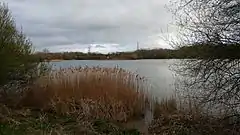 |
23.6 hectares (58 acres) | Theale 51.422°N 1.069°W SU 649 696 |
West Berkshire | BBOWT[37] | Map and details | The lake has a wide variety of water birds, including lapwings, little ringed plovers and great crested grebes. A wildflower meadow with many butterflies and moths is grazed by wild Exmoor ponies.[37] |
| Jock's Copse | .jpg.webp) |
1.5 hectares (3.7 acres) | Binfield 51.425°N 0.770°W SU 856 703 |
Bracknell Forest | Map and details | This is ancient coppiced wood mainly of oak and hazel with several wild service trees. Fauna include badgers, roe deer, bullfinches and all three British species of woodpecker.[38] | |
| Lavells Lake | 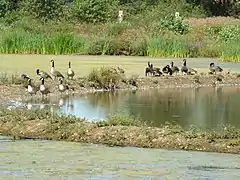 |
12.5 hectares (31 acres) | Woodley 51.450°N 0.875°W SU 783 729 |
Wokingham | Map and details | The site is part of Dinton Pastures Country Park, which was previously used for gravel extraction and now has eight lakes. The LNR is centred on one of the lakes and is managed to encourage its bird population. There are also islands and meadows.[39][40] | |
| Longmoor Bog |  |
11.8 hectares (29 acres) | Finchampstead 51.381°N 0.879°W SU 781 653 |
Wokingham | SSSI[41] | Map and details | This is mainly carr woodland, together with areas of wet heath and secondary mixed woodland. A small stream runs through the carr woodland, which has peat to a depth of more than a metre covered by mosses. The wet heath is important for insects, such as the bog bush cricket, silver-studded blue butterfly, emperor dragonfly, waved black moth and wood ant.[42] |
| Lousehill Copse |  |
13.0 hectares (32 acres) | Tilehurst 51.455°N 1.021°W SU 681 733 |
Reading | Map and details | This site is in the middle of housing. It is mainly semi-ancient oak and hazel woodland on sand gravel. There is also a meadow, an old pond and marshy areas.[43] | |
| Maiden Erlegh Lakes | 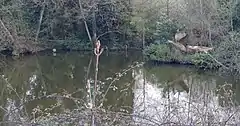 |
10.2 hectares (25 acres) | Earley 51.433°N 0.924°W SU 749 710 |
Wokingham | Map and details | This site has lakes, ancient semi-natural woodland deciduous woodland.[44] Features include a tern nesting platform and a sculpture called The Duck and the World. Fishing is allowed in the lake.[45] | |
| The Marshes | .jpg.webp) |
2.2 hectares (5.4 acres) | Swallowfield 51.364°N 0.947°W SU 734 633 |
Wokingham | Map and details | The main part of this site is a former horse paddock which was planted with 1400 native shrubs and trees between 2004 and 2008. A pond and boardwalk were constructed in a small area of wet woodland.[46] | |
| McIlroy Park |  |
12.0 hectares (30 acres) | Reading 51.464°N 1.027°W SU 677 743 |
Reading | Map and details | The park has views over the River Thames, and a sunken ancient track called Gypsy Lane, which is lined with beech trees. Most of it is grassland broom, but there also areas of semi-ancient woodland, one of which has disused chalk quarries.[47] | |
| Ockwells Park | .jpg.webp) |
9.3 hectares (23 acres) | Maidenhead 51.499°N 0.734°W SU 880 786 |
Windsor and Maidenhead | Map and details | The LNR is the nature reserve part of a larger park. It has paths and a nature trail through areas of woodland, meadow and copses.[48] | |
| Padworth Common |  |
28.0 hectares (69 acres) | Burghfield Common 51.377°N 1.112°W SU 619 646 |
West Berkshire | BBOWT[49] | Map and details | This site is mainly heath, but there are also areas of grassland, wet gullies, ponds and oak and pine woodland. There is a variety of heathland birds, such as Dartford warbler, tree pipit, stonechat, woodlark and the rare nightjar. The pond has many dragonflies and damselflies.[49] |
| Park Wood and Goulding's Wood | .jpg.webp) |
35.3 hectares (87 acres) | Maidenhead 51.546°N 0.770°W SU 854 837 |
Windsor and Maidenhead | Map and details | This mature wood is mainly oak and beech on clay soils. There are several sequoia trees which were planted in the Victorian period. There are ponds and dells in the north of the site, which is dominated by rhododendrons.[50] | |
| Pearman's Copse |  |
6.9 hectares (17 acres) | Lower Earley 51.418°N 0.944°W SU 735 693 |
Wokingham | Map and details | This is an ancient wood with ash, hazel and oak trees. It has archaeological features such as boundary banks and ditches.[51] | |
| Piggy Wood | .jpg.webp) |
2.3 hectares (5.7 acres) | Warfield 51.428°N 0.749°W SU 871 706 |
Bracknell Forest | Map and details | In the summer damselflies and dragonflies can be seen along a tributary of The Cut, which runs through the wood. Flora include wood anemone, marsh marigold and wood avens.[52] | |
| Round Copse | 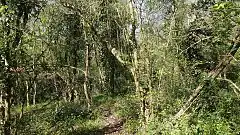 |
1.7 hectares (4.2 acres) | Reading 51.461°N 1.025°W SU 678 740 |
Reading | Map and details | This dense wood has diverse birds, including all three British species of woodpecker, nuthatches, treecreepers, thrushes and blackbirds.[53] | |
| Sutherland Grange | _(15142881791).jpg.webp) |
3.2 hectares (7.9 acres) | Windsor 51.485°N 0.649°W SU 939 771 |
Windsor and Maidenhead | Map and details | Part of this open space is a conservation area. A field called Sutherland Grange Hay Meadow has diverse species of flowers and grasses, with insects which provide a food source for birds in the surrounding hedges and trees.[54] | |
| Swallowfield Meadow |  |
0.7 hectares (1.7 acres) | Swallowfield 51.377°N 0.958°W SU 726 647 |
Wokingham | Map and details | This small site has diverse habitats with grassland, woodland, ditches, hedges and seasonal ponds. Mammals include the endangered water vole and there are trees such as silver birch, field maple and hazel.[55] | |
| Temple Copse | .jpg.webp) |
1.9 hectares (4.7 acres) | Binfield 51.424°N 0.775°W SU 853 702 |
Bracknell Forest | Map and details | This is one of the Three Copses, together with Jock's and Tinkers. The dominant trees in this wood are oak and hazel. Fauna include badgers, squirrels, bullfinches and jays.[56] | |
| Thatcham Reedbeds | 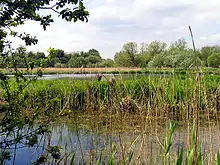 |
14.0 hectares (35 acres) | Thatcham 51.424°N 0.775°W SU 500 667 |
West Berkshire | BBOWT,[57] SAC,[58] SSSI[59] | Map and details | The site is described by Natural England as nationally important for its reed beds, fen and species rich alder woods. It is also nationally important for Desmoulin's whorl snails and there are many breeding birds, such as the nationally rare Cetti's warbler. Wetland plants include common valerian, skullcap and marsh bedstraw.[60] |
| Tinkers Copse | .jpg.webp) |
1.9 hectares (4.7 acres) | Binfield 51.426°N 0.770°W SU 856 704 |
Bracknell Forest | Map and details | This ancient coppiced wood has a wide variety of wildlife. Fauna include bullfinches, badgers, roe deer and all three species of british woodpecker.[61] | |
| Whitegrove Copse | .jpg.webp) |
3.6 hectares (8.9 acres) | Warfield 51.423°N 0.739°W SU 878 701 |
Bracknell Forest | Map and details | This site is ancient coppiced woodland with diverse wildlife. Flora include ragged robin and the wild service tree, while there are birds such as bullfinches, blackcap and chiffchaff.[62] |
See also
Notes
- The area is taken from the Natural England map of each site. (Click on the identify icon (i) in the "Feature Tools" and then click on the site.)
- The location is taken from the Natural England details page for the site.
- The maps are on the Natural England database of local nature reserves.
- Details are on the pages on each site in the Natural England database of local nature reserves.[3]
References
- "Local Nature Reserve". Peak District National Park Authority. 15 February 2017. Retrieved 3 February 2020.
- "Local nature reserves: setting up and management". Department for Environment, Food & Rural Affairs and Natural England. 2 October 2014. Archived from the original on 4 July 2015. Retrieved 29 July 2015.
- "Designated Sites View: Berkshire". Local Nature Reserves. Natural England. Retrieved 20 January 2020.
- "Map of South East England". Visit South East England. Archived from the original on 21 January 2019. Retrieved 22 January 2020.
- "Your Guide to the Counties of England". Counties in England. Archived from the original on 10 October 2016. Retrieved 22 January 2020.
- "Berkshire". Encyclopædia Britanica. Archived from the original on 12 April 2019. Retrieved 22 January 2020.
- "The Ceremonal County of Berkshire". Berkshire Lieutenancy. Archived from the original on 28 June 2019. Retrieved 20 January 2020.
- "Alder Moors". Local Nature Reserves. Natural England. Retrieved 20 January 2020.
- "Ali's Pond". Local Nature Reserves. Natural England. Retrieved 25 October 2019.
- "Ambarrow Court". Local Nature Reserves. Natural England. Retrieved 30 October 2019.
- "The Arthur Jacob Nature Reserve". Horton Parish Council. Archived from the original on 30 October 2019. Retrieved 30 October 2019.
- "Designated Sites View: Chilterns Beechwoods". Special Areas of Conservation. Natural England. Retrieved 3 October 2019.
- "Designated Sites View: Bisham Woods". Sites of Special Scientific Interest. Natural England. Retrieved 3 October 2019.
- "Bisham Woods citation" (PDF). Sites of Special Scientific Interest. Natural England. Archived (PDF) from the original on 16 October 2019. Retrieved 16 October 2019.
- "Blundells Copse". Local Nature Reserves. Natural England. Retrieved 31 October 2019.
- "Bradnam Wood". Local Nature Reserves. Natural England. Retrieved 20 January 2020.
- "Braywick Park". Local Nature Reserves. Natural England. Retrieved 31 October 2019.
- "Carpenter's Wood". Local Nature Reserves. Natural England. Retrieved 20 January 2020.
- "Clayfield Copse". Local Nature Reserves. Natural England. Retrieved 1 November 2019.
- "Clayfield Copse and Blackhouse Woods". Reading Borough Council. Archived from the original on 4 July 2019. Retrieved 1 November 2019.
- "Cocksherd Wood". Woodland Trust. Retrieved 2 February 2020.
- "Cocksherd Wood". Local Nature Reserves. Natural England. Retrieved 29 October 2019.
- "Edgbarrow Woods". Local Nature Reserves. Natural England. Retrieved 1 November 2019.
- "Designated Sites View: Englemere Pond". Sites of Special Scientific Interest. Natural England. Retrieved 4 October 2019.
- "Englemere Pond citation" (PDF). Sites of Special Scientific Interest. Natural England. Archived (PDF) from the original on 15 October 2019. Retrieved 15 October 2019.
- "Farley Copse". Local Nature Reserves. Natural England. Retrieved 22 December 2019.
- "The Gullet". Local Nature Reserves. Natural England. Retrieved 30 December 2019.
- "Hayley Green Wood". Local Nature Reserves. Natural England. Retrieved 22 December 2019.
- "Haymill Valley". Berkshire, Buckinghamshire and Oxfordshire Wildlife Trust. Archived from the original on 8 October 2019. Retrieved 8 October 2019.
- "Designated Sites View: Heath Lake". Sites of Special Scientific Interest. Natural England. Retrieved 4 October 2019.
- "Heath Lake citation" (PDF). Sites of Special Scientific Interest. Natural England. Archived (PDF) from the original on 16 October 2019. Retrieved 16 October 2019.
- "Heathlake – Site of Special Scientific Interest". Wokingham District Council. Archived from the original on 30 March 2019. Retrieved 16 October 2019.
- "Herschel Park". Local Nature Reserves. Natural England. Retrieved 30 October 2019.
- "Highwood Nature Reserve". Wokingham Borough Council. Archived from the original on 16 October 2019. Retrieved 20 January 2020.
- "Highwood". Local Nature Reserves. Natural England. Retrieved 20 January 2020.
- "Holt Copse & Joel Park". Local Nature Reserves. Natural England. Retrieved 1 November 2019.
- "Hosehill Lake". Berkshire, Buckinghamshire and Oxfordshire Wildlife Trust. Archived from the original on 1 November 2019. Retrieved 17 September 2019.
- "Jock's Copse". Local Nature Reserves. Natural England. Retrieved 22 December 2019.
- "Lavells Lake". Local Nature Reserves. Natural England. Retrieved 1 November 2019.
- "History of Dinton Pastures". Dinton Pastures Country Park. Archived from the original on 1 November 2019. Retrieved 1 November 2019.
- "Designated Sites View: Longmoor Bog". Sites of Special Scientific Interest. Natural England. Retrieved 5 October 2019.
- "Longmoor Bog citation" (PDF). Sites of Special Scientific Interest. Natural England. Archived (PDF) from the original on 20 October 2019. Retrieved 20 October 2019.
- "Lousehill Copse". Local Nature Reserves. Natural England. Retrieved 1 November 2019.
- "Maiden Erlegh Lakes". Local Nature Reserves. Natural England. Retrieved 2 November 2019.
- "Maiden Erlegh Nature Reserve". Earley Town Council. Archived from the original on 2 November 2019. Retrieved 2 November 2019.
- "The Marshes Restoration Project, Swallowfield. 2004—2008" (PDF). Wokingham Borough Council. Retrieved 24 November 2019.
- "McIlroy Park". Local Nature Reserves. Natural England. Retrieved 2 November 2019.
- "Ockwells Park". Local Nature Reserves. Natural England. Retrieved 31 December 2019.
- "Padworth Common". Berkshire, Buckinghamshire and Oxfordshire Wildlife Trust. Archived from the original on 1 November 2019. Retrieved 2 November 2019.
- "Park Wood and Goulding's Wood". Local Nature Reserves. Natural England. Retrieved 3 November 2019.
- "Pearman's Copse". Local Nature Reserves. Natural England. Retrieved 3 November 2019.
- "Piggy Wood". Woodland Trust. Archived from the original on 23 December 2019. Retrieved 23 December 2019.
- "Round Copse". Local Nature Reserves. Natural England. Retrieved 4 November 2019.
- "Sutherland Grange". Local Nature Reserves. Natural England. Retrieved 4 November 2019.
- "Swallowfield Meadow". Local Nature Reserves. Natural England. Retrieved 5 November 2019.
- "The Tree Copses". Bracknell Forest Borough Council. Archived from the original on 23 December 2019. Retrieved 23 December 2019.
- "Thatcham Reedbeds". Berkshire, Buckinghamshire and Oxfordshire Wildlife Trust. Archived from the original on 8 October 2019. Retrieved 16 September 2019.
- "Designated Sites View: Kennet & Lambourn Floodplain". Special Areas of Conservation. Natural England. Retrieved 4 October 2019.
- "Designated Sites View: Thatcham Reed Beds". Sites of Special Scientific Interest. Natural England. Retrieved 8 October 2019.
- "Thatcham Reed Beds citation" (PDF). Sites of Special Scientific Interest. Natural England. Archived (PDF) from the original on 24 October 2019. Retrieved 24 October 2019.
- "Tinkers Copse". Local Nature Reserves. Natural England. Retrieved 23 December 2019.
- "Whitegrove Copse". Local Nature Reserves. Natural England. Retrieved 26 December 2019.